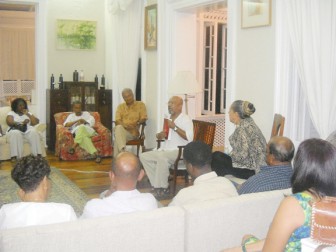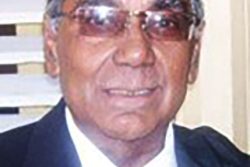For more than an hour last Wednesday, Professor Clem Seecharan discussed and read excerpts from his latest publication Mother India‘s Shadow over El Dorado: Indo Guyanese politics & Identity 1890s-1930s outlining to the small gathering at Moray House some significant changes that occurred in the East Indian community during this period.
Between the 1890s and 1930s, the East Indian community in British Guiana experienced major political and social changes which Seecharan asserted were significantly influenced by the rise of an Indian intellectual class and the presence of a liberal press.
Seecharan is a Professor of Caribbean History and has been the Head of Caribbean Studies at the London Metropolitan University since 1993. He has produced several books including Bechu: ‘Bound Coolie‘ Radical in British Guiana, 1894-1901 and Sweetening ‘Bitter Sugar’: Jock Campbell, the Booker Reformer in British Guiana, 1934-66.

Describing the work as one of his most challenging publications to date, the UK-based historian and writer said that he depended on writings which appeared in the Daily Chronicle, New Daily Chronicle and the Daily Argosy—three popular newspapers in British Guiana at the time. The newspapers, he pointed out, provided locals with the opportunity to express themselves via letters and in columns. “In the colonial period, when this democracy was severely circumscribed people had the opportunity in the press, in the liberal press to ventilate their opinions. And they would cuss the governor, and they would cuss the chief secretary and they could do all of these things,” he said. He noted that during this period several East Indians—such as Peter Ruhoman and Lala Lajpat, among others—had columns in the newspaper.
Seecharan noted that East Indians in British Guiana were significantly influenced by the Gandhian movement and the Indian nationalist struggle. A lot of what happened in India was reported in the local newspapers at that time Seecharan noted.
However, while there was greater exposure to a body of knowledge, there was very high illiteracy among Indian girls, due in part to legislative changes, particularly the introduction in 1902 of the Swettenham circular promulgated by Governor Alexander Swettenham.
This circular, which was implemented in collaboration with the planters in the country, did not make education compulsory in the rural areas if a child’s parents objected. Previously the compulsory Educational Ordinance of 1876, stipulated that in Georgetown and New Amsterdam children had to go to school up to the age of 14 but in rural areas they had to go to school up to the age of 12. However, the Swettenham circular made it clear that in rural areas if Indian parents objected to the children going to school, the compulsory education ordinance should be waived and the parents not be prosecuted.
J I Ramphal, was one of the persons who fought against this, challenging the planters, the Brahmin priests and the large number of persons who did not feel this circular should go. According to Secharan, Ramphal’s fight was in part influenced by the nationalist movement in India. He would point to cases in India where women in India graduated from university with degrees and to their role in the Indian National Congress.
Seecharan noted though that during this period there was a call for the East Indian community to look to the motherland for inspiration and to reclaim something of themselves, just as the Africans were doing. “So when a man like Joseph Ruhoman in 1894 delivered the first lecture given by an Indian in the Caribbean, he was saying you must as Indians in British Guiana emulate what the African people are doing in this country,“ the professor said. Ruhoman, Seecharan continued, was talking about an educated lower-middle class which was redefining the parameters of these societies and laying groundwork for liberal democratic traditions.
According to Secharan, Ruhoman was saying to the East Indian community that they needed “to go beyond the idea of the coolie.”
“You’ve got to begin see yourself as people who belong here and who have a contribution to make and to move beyond the idea of the coolie, you’ve got to give yourself the way African people and coloured or mixed race people and Portuguese people and so on were doing in this city,” the professor said.
Many people were creating a notion of homeland that was totally at variance to their situation at home because it was too painful to revisit. He made reference to the “cultivation of collective amnesia.” The professor noted that people in the sugarcane fields had a powerful concept of ancient history taken from great Hindu texts, especially the Ramayan.
In reality, the majority of East Indian immigrants who were in British Guiana at the time had escaped from parts of India where famine and plague were chronic. He pointed to the high percentage of child widows (12-13 year-old girls) who came to this region because they had nowhere to go when their husbands died in India. According to Seecharan, two-thirds of the women who came to British Guiana and to Trinidad as indentured immigrants came here unaccompanied.
Many of the East Indians who remained here, dreamt of a “golden age” which they would experience in British Guiana—a notion which was reinforced by the myth of Eldorado. This utopian vision of British Guiana, Seecharan noted, was key for survival here.
Seeharan said that the book is a body of knowledge that would hopefully move the people beyond the body of problems we have been dealing with for a long time. He noted that there were controversial issues addressed in the book which have implications for the racial division which exists today, mentioning that at one point some spoke about creating an Indian colony here within the British Guiana Indian Association.
Copies of the book are expected in the country shortly and will be available at the Austin’s Bookstore.








